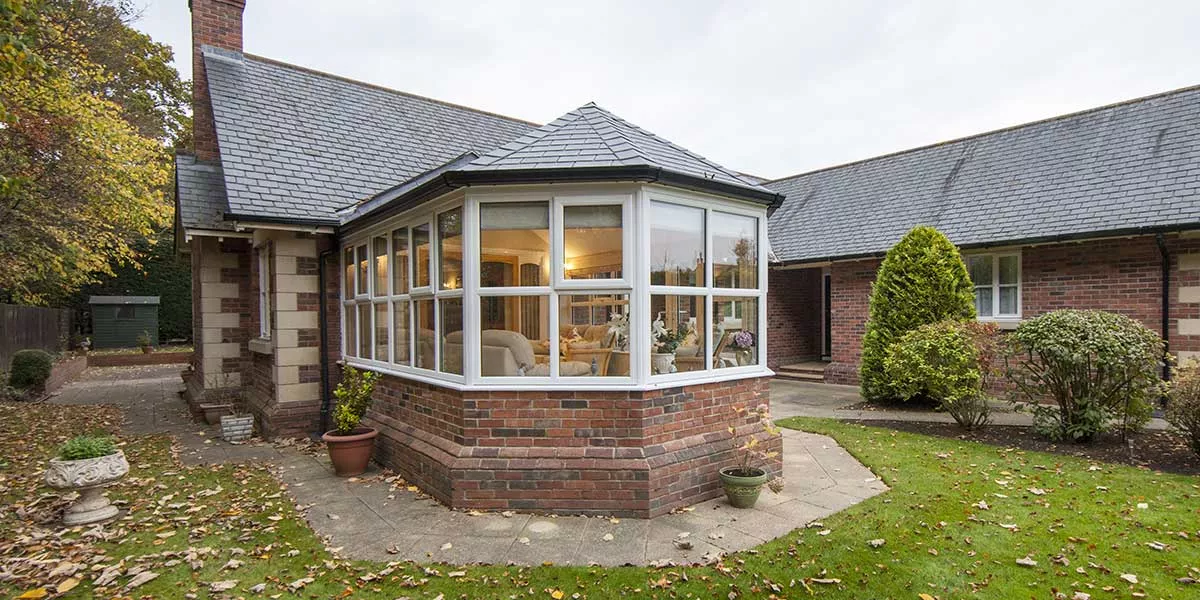When making a choice between an orangery vs conservatory, every homeowner wonders about the differences and benefits. In our article, we have tried to touch on the main aspects to help with the choice and the right decision:
Structure: Orangeries feature sturdy brick bases and less glass, emphasizing a traditional aesthetic, whereas conservatories are predominantly glass and offer flexibility in design.
Benefits: Both structures increase natural light and property value. Conservatories allow various shapes; orangeries provide seamless architectural integration.
These points should guide homeowners in determining which option best aligns with their needs and preferences.

They are very different structures and you may well discover that one complements your property more than the other.
What is an Orangery?
Conservatories are better known amongst householders than orangeries, called an orangery as back in the 17th century, wealthy landowners would use them as locations to grow oranges and other citrus fruits.
Elegant and light-filled spaces that originated in Italy, orangeries are identifiable by their brick base, brick pillars, large windows and doors, and flat perimeter roof featuring a central roof lantern.
They traditionally have less than 50% glass or polycarbonate side walls and less than 75% glass or polycarbonate roof area.
Adaptability extends to omitting the brick pillars and including floor-to-ceiling glass to maximise your view for an enhanced communion with nature and drive in considerable light.
What is a Conservatory?
Advancements in materials and efficiency technologies have seen conservatory designs drastically evolve from the times when they would often be standalone buildings, rather than attached to houses, and used for growing plants more so than for living purposes.
A present-day conservatory will have abundant light and generally encompasses well-insulated glass walls, a glass or solid tiled roof, and UPVC or aluminium framework (occasionally timber too), with a glass ratio above 75%, otherwise you would class it as an orangery.
Most conservatory designs have a square or rectangular formation, but you have varieties in shape like the T-shape, P-shape, and L-shape conservatory, and most come under permitted development rights, removing the need for planning permission.
What are the Benefits of a Conservatory vs an Orangery?
You’re on to a winner whichever you deem is your favourite out of a conservatory and orangery as they each have a string of benefits to them, several of which are mutual, so let’s start with those:
Draw in lots of natural lighting from the sun
Uplift a home’s valuation and provide a major selling-point
Offer flexible living options
Crafted bespoke, so can be fully personalised
Provide extra, useable floor space
Enjoy permitted development rights if kept to the relevant limits and conditions, circumventing a need for planning permission.
As for any benefits one holds over the other, or vice-versa, conservatories can be styled in a greater array of shapes, including square, rectangular, T-shaped, P-shaped, L-shaped, and so on, but you can more easily fashion an orangery to mimic a home’s existing aesthetic.
Advise us if you don’t know where you stand in the ongoing orangery vs conservatory discussion and we’ll relay all the other benefits.
Which is Cheaper: Conservatory or An Orangery?
For what you get, we firmly believe that an orangery and conservatory both offer superb long-term value, but we recognise that cost will come into the reckoning and influence which is the most affordable to you.
Speculating a price is best avoided by us as we really need to talk to you first to ascertain what size of extension you want and how complex or uncomplicated the design will be. We can confirm though in advance of a conversation that orangeries are generally more expensive as the build process involved can be lengthier and more intricate.
On the odd occasion, certain conservatory styles can be similarly priced, but by and large, orangeries need a bigger outlay to buy.
How Do You Choose Between an Orangery or Conservatory?
We don’t envy a customer trying to select between an orangery or conservatory as they are both stunning enhancements in their own right.
Are you more enticed by an extension with brick walls, a flat roof and central lantern roof, which is what you get with an orangery, or a predominantly glazed structure containing a pitched roof, your archetypal conservatory?
Orangeries are seen as more natural extensions of properties because of being largely made up of brick, suiting the architectural style of your house perhaps more than a glass structure if you believe it may be an improper addition.
How much available space you have to extend and the desired functionality of the location could also sway your decision, but there’s little to choose between the two here as both can be built to numerous sizes and offer various purposes.